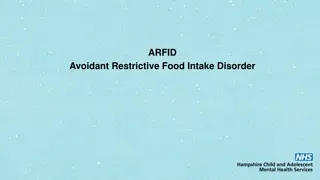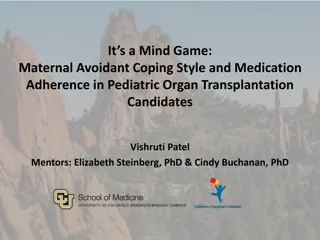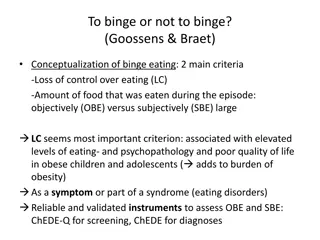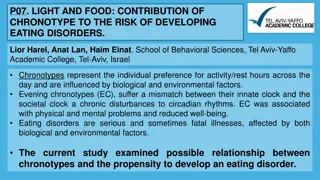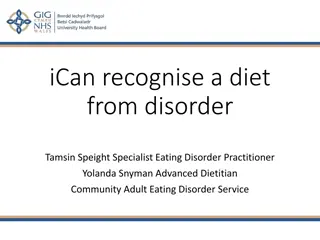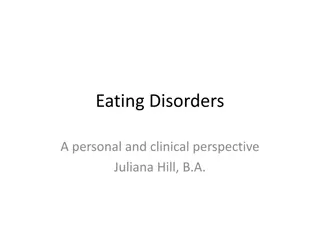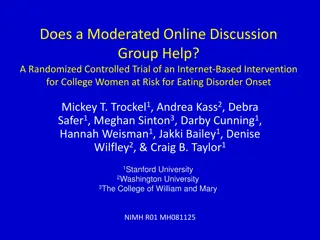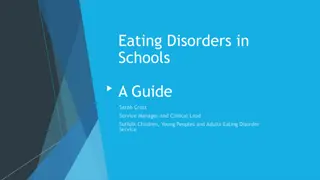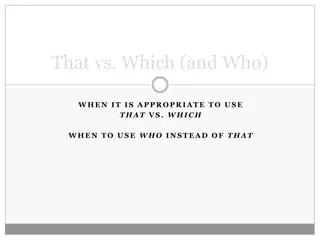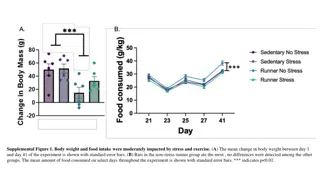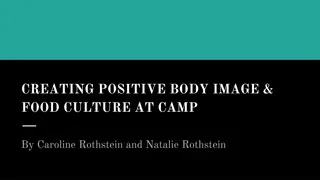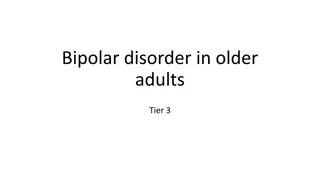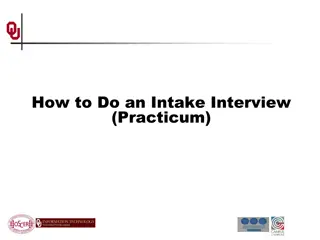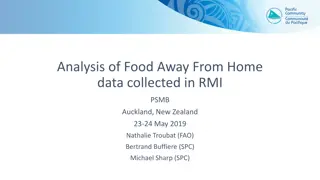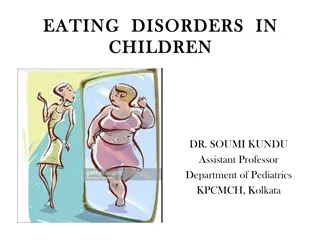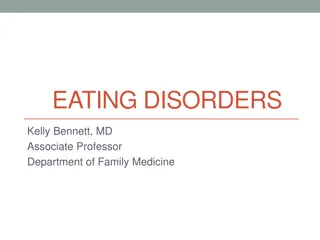The Link Between Picky Eating and Avoidant/Restrictive Food Intake Disorder in High School Students
Picky eating behaviors in children can potentially lead to Avoidant/Restrictive Food Intake Disorder (ARFID) if not outgrown by age 6. Research indicates that parental pressure, aversive experiences, and specific eating characteristics are associated with picky eating tendencies that may predict ARFID development. The study explores these connections through a comprehensive literature review and a tailored methodology involving high school student participants.
Download Presentation

Please find below an Image/Link to download the presentation.
The content on the website is provided AS IS for your information and personal use only. It may not be sold, licensed, or shared on other websites without obtaining consent from the author. Download presentation by click this link. If you encounter any issues during the download, it is possible that the publisher has removed the file from their server.
E N D
Presentation Transcript
Picky Eating in relation to Avoidant/ Restrictive Food Intake Disorder in high school students By Zoe Falcone
Introduction Picky eating the refusal to eat novel foods only eating the same typical comfort foods Children who do not outgrow picky eating higher risk for Avoidant/Restrictive Food Intake Disorder (ARFID) risk increases past age 6
Introduction ARFID- a restrictive eating disorder characterized by Sensory sensitivity Lack of interest Aversive consequences
Literature Review ARFID presents as constant failure to meet appropriate nutritional, weight, and energy needs Feillet, F., Bocquet, A., Briend, A., Chouraqui, J.-P., Darmaun, D., Frelut, M.-L., Dupont, C. (2019). Nutritional risks of ARFID (avoidant restrictive food intake disorders) and related behavior. Archives de P diatrie. doi:10.1016/j.arcped.2019.08.005
Literature Review Parental pressure to eat and aversive experiences were associated with general picky eating behavior. Feillet, F., Bocquet, A., Briend, A., Chouraqui, J.-P., Darmaun, D., Frelut, M.-L., Dupont, C. (2019). Nutritional risks of ARFID (avoidant restrictive food intake disorders) and related behavior. Archives de P diatrie. doi:10.1016/j.arcped.2019.08.005
Literature Review Picky eating is characterized by high food pickiness, slowness when eating, low enjoyment of food, and low food responsiveness Tharner, A., Jansen, P. W., Kiefte-de Jong, J. C., Moll, H. A., van der Ende, J., Jaddoe, V. W., Franco, O. H. (2014). Toward an operative diagnosis of fussy/picky eating: a latent profile approach in a population- based cohort. International Journal of Behavioral Nutrition and Physical Activity, 11(1), 14.
Picky eating, along with diagnostic factors, significantly predict tendencies toward Avoidant / Restrictive Food Intake Disorder (ARFID). Hypothesis
Methodology Picky Eating in relation to Avoidant/Restrictive Food Intake Disorder questionnaire Combination of diagnostic questions by Wardle, Guthrie, Sanderson, and Rapoport and new Diagnostic Factors Sample population High School students Grades 9-12
Methodology Diagnostic Factors of Picky Eating: Gender Negative outlook on own body image Willingness to attend social functions Open-mindedness to trying new foods Sensory issues
Methodology Picky Eating in relation to Avoidant/Restrictive Food Intake Disorder questionnaire Will you avoid going to a social function if you don't know what food will be there? Do you refuse to eat new foods when you are introduced to them? Will you ever refuse to eat something if it doesn't "look right" (e.g. burnt edges, broken cookies, undesirable color)?
RESULTS Independent samples t-test Mean difference Independent Samples t-test Diagnostic Factors .564425 Picky Eating .01415 ARFID .019037
RESULTS Gender Analysis
RESULTS Sub Scale Correlation Diagnostic Factors Picky Eating ARFID Sub Scale Correlation Diagnostic Factors 1 .666 .705 Picky Eating - 1 .699 ARFID - - 1
Discussion Gender prediction analysis Contrary to previous studies Picky eating May be confirmed as a pre cursor for ARFID Can be taken more seriously
Conclusion Hypothesis supported There are clear predictors of picky eating that significantly relate to Avoidant/Restrictive Food Intake Disorder Future work Protective measures against disordered eating Gender predictors of ARFID
Citations Avoidant Restrictive Food Intake Disorder. National Eating Disorder Association, 2018, Accessed 2018. www.nationaleatingdisorders.org/learn/by-eating-disorder/arfid. Brigham, K. S., Manzo, L. D., Eddy, K. T., & Thomas, J. J. (2018). Evaluation and Treatment of Avoidant/Restrictive Food Intake Disorder (ARFID) in Adolescents. Current Pediatrics Reports, 6(2), 107 113. Dovey, T. M., Kumari, V., & Blissett, J. (2019). Eating behaviour, behavioural problems and sensory profiles of children with avoidant/restrictive food intake disorder (ARFID), autistic spectrum disorders or picky eating: Same or different? European Psychiatry, 61, 56 62. Feillet, F., Bocquet, A., Briend, A., Chouraqui, J.-P., Darmaun, D., Frelut, M.-L., Dupont, C. (2019). Nutritional risks of ARFID (avoidant restrictive food intake disorders) and related behavior. Archives de P diatrie. Galloway, A. T., Lee, Y., & Birch, L. L. (2003). Predictors and consequences of food neophobia and pickiness in young girls. Journal of the American Dietetic Association, 103(6), 692 698. Keery, H., LeMay-Russell, S., Barnes, T. L., Eckhardt, S., Peterson, C. B., Lesser, J., Le Grange, D. (2019). Attributes of children and adolescents with avoidant/restrictive food intake disorder. Journal of Eating Disorders, 7(1). Nicely, T. A., Lane-Loney, S., Masciulli, E., Hollenbeak, C. S., & Ornstein, R. M. (2014). Prevalence and characteristics of avoidant/restrictive food intake disorder in a cohort of young patients in day treatment for eating disorders. Journal of Eating Disorders, 2(1). Tharner, A., Jansen, P. W., Kiefte-de Jong, J. C., Moll, H. A., van der Ende, J., Jaddoe, V. W., Franco, O. H. (2014). Toward an operative diagnosis of fussy/picky eating: a latent profile approach in a population-based cohort. International Journal of Behavioral Nutrition and Physical Activity, 11(1), 14.


